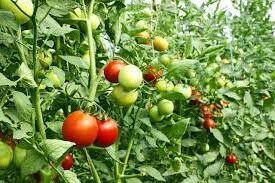How to create nursery bed for tomatoes or pepper on your farm or backyard garden.

How to create nursery bed for tomatoes or pepper on your farm or backyard garden.
To create a nursery bed for tomatoes and peppers;
Select a site that receives enough sunlight and is well-drained. It should also be protected from strong winds.
Clear the area of any weeds, rocks, or debris. Loosen the soil using a garden fork, hoe or a tiller. Remove any large clumps of soil and break them up to create a fine texture.
Construct raised beds by forming mounds to improve the drainage and prevent waterlogging. The bed should be about 3-5 inches high and should not be too wide.
Add organic matter such as compost (cow dunk or poultry dunk) or well-rotted manure to improve fertility and drainage. Mix it thoroughly into the existing soil.
Sow the seed according to the instructions in terms planting depth and spacing mention on the seed packet. But if the seeds are not bought from the market, maybe you extract you own seeds which you want to nurse. Use a straight pole to make a shallow hole on the nursery bed and spread the seeds in the holes evenly. Cover it with just a little soil.
After sowing the seeds, water the nursery bed thoroughly. Water regularly to keep the soil evenly moist, but avoid overwatering because, it can cause fungal diseases which may destroy the seedlings.
Provide a temporal shade to protect the young seedlings from direct sunlight. You can do this by using dead grasses or by using shade cloth.
Regularly inspect the nursery bed for any signs of pests or diseases. Take appropriate measures such as using organic insecticides or applying companion planting techniques to deter pests.
Before transplanting the seedlings into the main garden or farmland, it’s important to harden them off. Gradually expose the seedlings to direct sunlight by removing the shade over a period of 6-9 days.
Once the seedlings have been hardened off, they can be transplanted into the main garden or farmland.
Key factors to consider when planting tomatoes in your garden or farmland.

Tomatoes thrive in well-drained soil with good fertility. Prepare the soil by removing any weeds, rocks, or debris. Amend the soil with organic matter like compost or well-rotted manure to improve its structure, moisture retention, and nutrient content.
Tomatoes require regular and consistent watering. Keep the soil evenly moist, but not waterlogged. Provide deep watering to encourage root growth, and avoid wetting the foliage to reduce the risk of diseases. Mulching around the plants can help retain moisture and regulate soil temperature.
Tomatoes are heavy feeders and benefit from regular fertilization. Prior to planting, incorporate balanced organic fertilizer or slow-release granules into the soil. Additionally, side-dress the plants with a balanced fertilizer or use organic liquid fertilizers during the growing season according to the package instructions.
Tomatoes require a lot of direct sunlight, ideally at least 6-7 hours of full sun exposure per day. Choose a location in your garden that receives ample sunlight.
Avoid planting tomatoes outdoors until the danger of frost has passed and the soil temperature has warmed up.
Note;

- Peppers prefer well-drained soil with a pH level between 6.0 and 7.0.
- Peppers thrive in full sunlight, requiring at least 6-8 hours of direct sunlight per day.
- Peppers are warm-season crops and need warm temperatures to thrive.
- Peppers require consistent moisture, but overwatering can lead to root diseases.
- Peppers are moderate feeders and benefit from regular fertilization.






